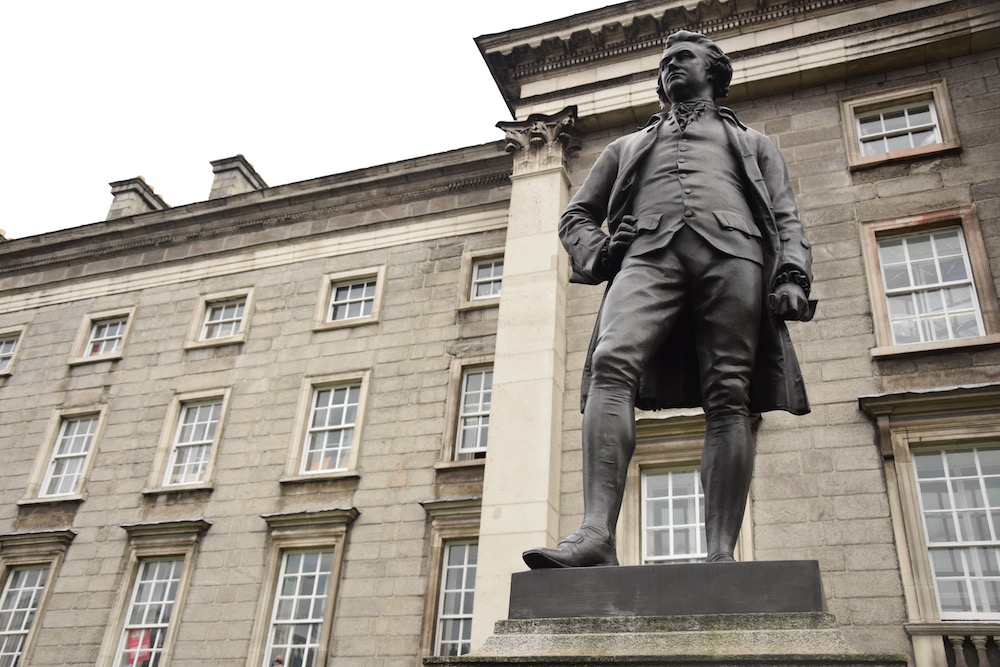As you walk through Front Gate, you may notice the bronze statue of Edmund Burke standing tall, erected in 1868 by the sculptor John H Foley. From John Joly to Mary Robinson, many have attended Trinity and gone on to become global leaders in their field. Burke is among those who still influence the world today, over two hundred years after his death.
The Anglo-Irishman hailed from Arran Quay, close to the present-day Four Courts. Born in 1729, he spent his early youth in a Quaker prep school in Kildare. Burke was one of thirteen children, though only four survived into adulthood. His father, Richard Burke, was a solicitor from the West of Ireland, and his mother, Mary Nagle, was a Cork native. His family was not of noble rank, though they were still deemed a “respectable family”.
“Toward the end of his time at Trinity, it became clear that Burke was no longer going to be sitting on the sidelines of politics.”
At the age of fifteen, Burke left the Quaker school and started his studies in Trinity. Mid-18th-century Dublin was a far cry from the Dublin we know today, and only 60,000 people inhabited the city. A vastly changing place, some of Dublin’s best-known architecture dates from this time, such as the Four Courts, the Custom House and Trinity’s own Rubrics building. Burke lived on campus and entered Trinity as a “pensioner”, paying monthly fees to the college. The book The Works of the Right Honourable Edmund Burke details Burke’s early life at Trinity.
Burke’s tutor in College was Dr Pelissier, and the provost at the time was Provost Baldwin, whose painting remains hanging in the Dining Hall. Burke was known as “a young man of superior, but unpretending talents .. and more anxious to acquire knowledge than to display it.” Whilst at Trinity, he studied the likes of history, political philosophy and metaphysics. In 1746 he was elected a Scholar, which he obtained by “considerable proficiency in the Classics.”
“Though he married before he turned thirty to Jane Mary Nugent, many maintain that he was secretly homosexual.”
Burke kept up a close correspondence with his friend Richard Shackleton. Though he married before he turned thirty to Jane Mary Nugent, many maintain that he was secretly homosexual. Over sixty letters between himself and Shackleton still survive, commencing with the likes of “Dear Dicky,” Dear Dick,” and “Dear Friend,” as detailed in a book by Katherine O’Donnell.
After he was awarded his scholarship, Burke found his studies “tedious” and subsequently became engrossed in novels, poetry and writings of the time. One of Burke’s long lasting legacies within Trinity was the founding of “the Club”. On 21 April 1747, the first meeting was held in a residence on South Great George’s Street. According to the Hist, there were six members, including Shackleton. From the minutes that were taken at the meetings, it appears that the function of the Club was “speeching, reading, writing and arguing, in Morality, History, Criticism, Politics and all the useful branches of philosophy.” In 1753, the Historical Society was founded, and later the two merged to form the “Hist” that we know today as the world’s oldest debating society.
At the age of 18, toward the end of his time at Trinity, it became clear that Burke was no longer going to be sitting on the sidelines of politics. It was then that he began his political writings, as he set out on a path that would eventually grant him his reputation as a renowned thinker.
“Burke found his studies ‘tedious’ and subsequently became engrossed in novels, poetry and writings of the time.”
In 1748, when Burke was in his final year in Trinity, he began co-writing and editing The Reformer, a weekly paper that lasted for thirteen editions. The publication shows a young Burke who is critical of English treatment toward poor Irish Catholics: “The riches of a nation are not to be estimated by the splendid appearance or luxurious lives of its gentry; it is the uniform plenty diffused through a people, of which the meanest as well as greatest partake, that makes them happy, and the nation powerful.” In his ultimate year as a Trinity student, Burke was also critical of the Dublin theatre scene, and he debated issues of reform in Burke’s Club.
Upon leaving Trinity, he set off to London and began to follow in his father’s footsteps by becoming a lawyer. In 1750, he began his studies in Middle Temple, but later failed to be called to the bar. He remained deeply interested in philosophy and literacy, and continued to develop his knowledge of global political movements and his political theories through numerous publications.
Burke is considered by many to be the father of modern conservatism, his philosophies heavily debated and relevant more than two centuries on. His portrait hangs in the National Gallery and his bronze statue safeguards the Front Gate at College Green. Perhaps one morning, when you scorn your early lectures, think of the political philosopher that Trinity’s largest lecture theatre is named after.







